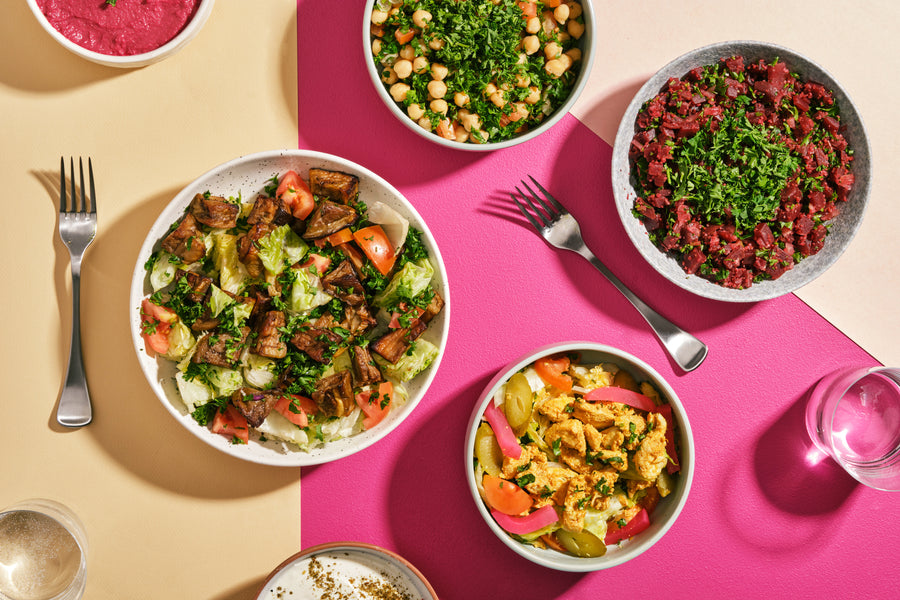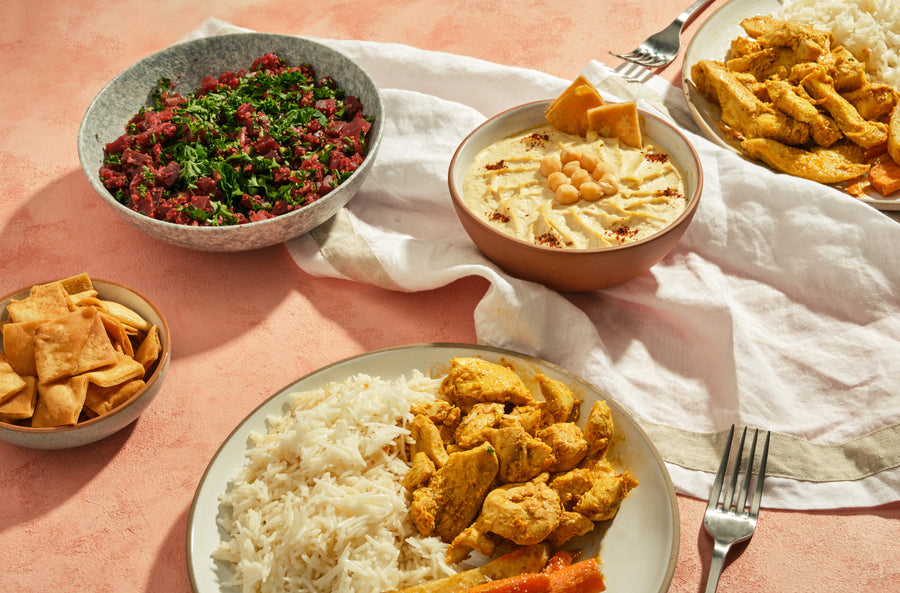A Deep Dive Into Syrian Cuisine: Comprehending Its Cultural Value and Halal Aspects
Syrian food symbolizes an abundant tapestry of historic stories and cultural impacts. Each meal informs a tale of neighborhood and custom, stressing the value of common dishes. The adherence to halal methods not just shows faiths however also forms the identification of Syrian food preparation. As global occasions test these cooking practices, the resilience of this cuisine remains a centerpiece of social preservation. What lies behind the tastes that specify this enduring heritage?
The Historic Roots of Syrian Food
Although Syrian food has developed over centuries, its historical roots are deeply linked with the area's varied cultural impacts. Situated at the crossroads of different civilizations, Syria has actually taken in culinary practices from the Phoenicians, Greeks, Romans, and Ottomans, among others. This abundant tapestry of background has actually added to a food defined by a blend of flavors, spices, and cooking methods. The fertile lands of the region have also played an essential duty, supplying a wealth of grains, fruits, and veggies that create the foundation of several recipes. The introduction of new active ingredients via profession and occupation better enhanced the culinary landscape, enabling for the advancement of one-of-a-kind local specializeds. Furthermore, the influence of bordering nations has resulted in a vibrant exchange of cooking ideas, strengthening Syria's position as a significant gamer in the broader context of Center Eastern gastronomy.

Traditional Syrian Dishes and Their Cultural Value
Typical Syrian recipes are not just cooking staples however likewise bring deep social importance, mirroring the country's abundant heritage. Iconic dishes, commonly prepared throughout cheery celebrations, act as a means of unifying areas and households. These meals personify the tastes of Syria while strengthening social bonds via shared customs and parties.
Iconic Syrian Staples
When checking out the rich tapestry of Syrian cuisine, one discovers a selection of renowned recipes that not just entice the taste buds however also embody the nation's social heritage. Amongst these staples, Kabsa attracts attention as an aromatic rice meal, frequently experienced with spices like saffron and cardamom, signifying hospitality. Fattoush, a vivid salad made with mixed eco-friendlies and crispy bread, mirrors the significance of fresh active ingredients in Syrian cooking. Muhammara, a spicy dip made from walnuts and peppers, showcases the rich tastes particular of the region. In addition, Kibbeh, a meal made from bulgur and minced meat, is typically considered a nationwide prize, representing common celebrations. Each meal informs a story, connecting individuals to their roots and traditions.
Joyful Dish Traditions
Syrian joyful meal practices are abundant with significance and importance, as households collect to celebrate essential celebrations via the sharing of precious dishes. Meals typically display a range of conventional foods, with recipes like mansaf, tabbouleh, and kibbeh taking center stage. Each recipe lugs cultural background; for circumstances, kibbeh, made from bulgur and minced meat, represents friendliness and abundance. Throughout Ramadan and Eid, family members prepare unique desserts such as maamoul, signifying joy and unity. These gatherings foster neighborhood bonds, as sharing a dish represents love and togetherness. The prep work and enjoyment of these recipes reflect Syria's varied cooking heritage, linking family personalizeds and regional impacts, thus improving the cheery experience and protecting social identity.
The Role of Household and Community in Syrian Food Society
Food serves as an important string that weaves together household and community in Syrian society. Dishes are typically public experiences, where families gather around a table to share traditional dishes that reflect their heritage. The preparation of food is a public activity, with generations functioning side by side, passing down recipes and food preparation strategies. This method strengthens familial bonds and fosters a sense of belonging within the community.Special occasions and religious parties additionally highlight the significance of food in Syrian society. Throughout these occasions, households prepare sophisticated dishes that offer not only to nurture but likewise to share love and hospitality. The act of sharing food represents unity and support amongst next-door neighbors and friends, reinforcing social ties. Via these shared culinary experiences, Syrians cultivate a strong identification rooted in their rich social history, highlighting just how food goes beyond plain food to end up being a crucial component of their social fabric.
Halal Practices in Syrian Food Preparation
In the context of communal meals and family members celebrations, halal methods play a substantial role in Syrian cooking. These practices originate from Islamic dietary legislations, making sure that food is ready and eaten in a way that lines up with faiths. For lots of Syrian families, adherence to halal principles affects various aspects of dish preparation, from sourcing ingredients to cooking methods.Animals made use of for meat must be butchered according to particular guidelines, stressing humane therapy and conjuring up the name of Allah. In addition, cross-contamination with non-halal items is meticulously avoided in both home kitchen areas and industrial establishments.This commitment to halal not only reflects spiritual dedication however likewise cultivates a feeling of neighborhood, as family members typically collaborated to share meals that recognize these customs - Brunch Kitsilano Vancouver BC. Halal practices are deeply woven into the textile of Syrian cooking culture, shaping both daily life and joyful celebrations.
Components That Define Syrian Tastes

The significance of Syrian cuisine is shaped by an unified blend of essential spices and herbs that improve its distinct flavors. Traditional food preparation techniques additionally elevate these active ingredients, showcasing the abundant cooking heritage of the area. A review of crucial active ingredients exposes the foundational role they play in producing genuine Syrian dishes.
Trick Spices and Herbs
A vivid tapestry of flavors characterizes Syrian food, with key seasonings and natural herbs playing a necessary function in specifying its significance. Popular amongst these are cumin, sumac, and coriander, which offer deepness and warmth to numerous dishes. Cumin, with its nutty fragrance, frequently boosts stews and grilled meats, while coriander adds a citrusy note to dips and salads. Sumac, understood for its zesty taste, brightens meals and is regularly sprinkled over fattoush or kebabs. Furthermore, cinnamon and allspice give a refined sweetness, generally discovered in both sweet and mouthwatering preparations. Fresh herbs like parsley, mint, and dill are additionally important, providing a ruptured of quality and balancing the rich, complicated tastes that make Syrian food one-of-a-kind.
Traditional Food Preparation Techniques
Cooking methods in Syrian cuisine reflect an ingrained tradition that enhances the tastes of its active ingredients. Approaches such as slow-cooking look these up and braising are typically employed, enabling natural herbs and seasonings to meld perfectly with meats and veggies. Cooking, particularly over charcoal, gives a smoky splendor to meals like kebabs, while steaming is often used for rice, preserving its texture and preference. In addition, sautéing is favored for preparing aromatic bases, typically beginning with onions and garlic to build depth. Fermentation plays a function in producing special flavors, obvious in dishes like pickled veggies. These strategies not just highlight the quality of active ingredients however likewise symbolize the communal spirit of cooking, bringing families with each other around shared meals soaked in tradition.
Necessary Active Ingredients Summary
While discovering Syrian cuisine, one quickly discovers that necessary active ingredients play an essential duty in defining its distinct tastes. Olive oil, a staple, supplies richness and deepness, usually offering as a base for many recipes. Fresh natural herbs, such as mint, cilantro, and parsley, add lively scents and tastes, improving the general experience (Brunch Kitsilano Vancouver BC). Spices like cumin, coriander, and cinnamon are regularly used, adding warmth and complexity to dishes. In addition, Syrian cuisine heavily integrates grains, especially bulgur and rice, which offer as essential components in various recipes. Pulses, particularly lentils and chickpeas, supply both nutrition and texture. Together, these components create the harmonious equilibrium that characterizes Syrian meals, mirroring the nation's abundant culinary heritage and cultural significance
The Influence of Battle on Syrian Culinary Traditions
The war in Syria has actually functioned devastation across the country, its impact on cooking practices reveals an intricate interplay of durability and adjustment. As communities dealt with variation, traditional dishes were modified as a result of the deficiency of ingredients and resources. Family members usually depend on in your area available produce, incorporating brand-new flavors and methods right into their meals, which caused the emergence of unique interpretations of timeless dishes.Moreover, the war fostered a spirit of solidarity amongst displaced cooks and home cooks, who shared their cooking knowledge with social media sites and community kitchen areas. This sharing of recipes not only preserved social heritage yet likewise created a feeling of belonging among those affected by the conflict. Regardless of the hardships, the passion for food continues to be a unifying force, permitting people to preserve check this site out their identification and attach with their roots, even in exile. As a result, Syrian cuisine continues to develop in the middle of adversity, showing both an abundant background and contemporary durability.
Frequently Asked Concerns
What Prevail Cooking Methods Used in Syrian Cuisine?
Common food preparation techniques in Syrian cuisine include cooking, baking, sautéing, and stewing. These techniques improve appearances and tastes, permitting the development of diverse dishes that reflect the region's abundant cooking heritage and practices.
Exactly How Has Globalization Influenced Syrian Food?

Exist Vegetarian Options in Standard Syrian Dishes?
Vegetarian choices prevail in standard Syrian meals, including components like vegetables, chickpeas, and lentils. Popular dishes such as Mujadara and Falafel highlight this diversity, accommodating different dietary choices while preserving the rich flavors of the food.
What Beverages Pair Well With Syrian Meals?
Beverages that pair well with Syrian meals consist of mint tea, pomegranate juice, and ayran - Brunch Kitsilano Vancouver BC. These beverages match the flavors of conventional dishes, improving the dining experience while supplying stimulating contrasts to the rich, savory preferences
Just How Do Syrians Commemorate Food Throughout Holidays or Festivals?
Syrians celebrate food throughout vacations and events with intricate banquets, often featuring traditional dishes. Household celebrations highlight sharing meals, signifying unity and cultural heritage, while unique deals with and sweets highlight the cheery spirit and communal happiness. Traditional Syrian dishes are not only cooking staples but also lug deep cultural importance, mirroring the nation's abundant heritage. When discovering the abundant tapestry of Syrian cuisine, one finds a range of legendary meals that not just tantalize the taste but also embody the nation's cultural heritage. Syrian joyful dish practices are rich with symbolism and significance, as family members gather to celebrate crucial events through the sharing of cherished meals. Food preparation strategies in Syrian cuisine reflect a deep-rooted custom that boosts the tastes of its ingredients. Vegan options are common in conventional Syrian meals, featuring ingredients like lentils, chickpeas, and veggies.